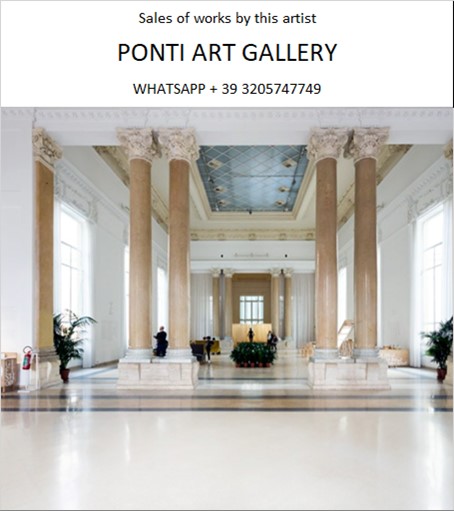Ponti Art Gallery is interested in buying and selling works
of art by this artist.

Lawrence Weiner Biography
Lawrence Weiner, born on February 10, 1942, in the Bronx, New York, emerged as a defining figure in the conceptual art movement of the 1960s. His pioneering approach to art-making significantly shifted the focus from traditional aesthetic objects to the conveyance of ideas through language. Weiner passed away on December 2, 2021, leaving behind a legacy that continues to influence contemporary art discourse.
Weiner's early life in the South Bronx was marked by a working-class upbringing. His parents ran a candy store, and this modest background would later inform his democratic approach to art. He attended New York public schools and graduated from Stuyvesant High School at the age of 16. After high school, Weiner's adventurous spirit led him to travel across North America, taking on various jobs and absorbing the cultural landscape of the country. These experiences enriched his understanding of American society and would later resonate in his artistic practice.
In the 1960s, Weiner became involved in the civil rights movement, participating in protests and engaging with social issues. This period of activism coincided with his burgeoning interest in art, which was further fueled by interactions with other artists in New York's vibrant creative scene. Weiner's engagement with art was not just a means of personal expression but also a platform for addressing broader cultural and political concerns.
Weiner's artistic breakthrough came in 1960 with "Cratering Piece," an earthwork that involved detonating explosions in a field in Mill Valley, California. This act of "sculpture by removal" was a precursor to his later text-based works, which would become his signature medium. By 1968, Weiner had formulated his "Declaration of Intent," a seminal text that outlined the principles of his art-making process:
The artist may construct the piece.
The piece may be fabricated.
The piece need not be built.
This declaration underscored the idea that the conception of an artwork was as valid as its physical realization, challenging traditional notions of what constituted an art object. Weiner's work henceforth would exist primarily as language, with the potential for manifestation in various forms and contexts.
Weiner's text pieces, often presented in capital letters and his own typeface, Margaret Seaworthy Gothic, were characterized by their lyrical and enigmatic qualities. They ranged from simple statements to complex abstractions, inviting viewers to engage with the work on a personal level. His use of language as a sculptural material broke down barriers between art and audience, allowing for a more inclusive and participatory experience.
Throughout his career, Weiner's work was exhibited internationally in galleries, public spaces, and museums, including the Museum of Modern Art in New York, Tate Modern in London, and the Whitney Museum of American Art. He participated in major exhibitions such as Documenta and the Venice Biennale, solidifying his status as a global art figure.
Weiner's influence extended beyond the art world, impacting graphic design and typography with his distinctive visual style. His commitment to accessibility was evident in his choice to display works in public spaces and produce artist books, posters, and films that reached a wider audience.
Despite his critical role in the development of conceptual art, Weiner eschewed the label, preferring to identify simply as a sculptor. His work transcended categorization, focusing instead on the interplay between objects, language, and the viewer's interpretation.
In his later years, Weiner continued to create and exhibit new works, maintaining a presence in both New York and Amsterdam, where he had a studio. His legacy is carried on through the countless artists he influenced and the enduring relevance of his ideas in contemporary art practice.
Lawrence Weiner's contributions to art are profound, not only in the way he redefined the art object but also in how he democratized the experience of art. His texts, at once poetic and provocative, continue to resonate, inviting us to consider the materiality of language and the power of ideas in shaping our engagement with the world.
Lawrence Weiner Quotes and
Sales of Works
Ponti Art Gallery selects and deals with paintings by the
artist. Upon request, we provide free estimates and
evaluations, communicate prices, quotations, and current
market values.
If you are interested in BUYING or SELLING works by the
artist, contact us immediately.
If you wish to sell or receive an evaluation of the
works:
Send us a frontal photo of the painting, one of the back,
and one of the signature. Also, indicate the dimensions of
the work. Inform us about the purchase origin of the work
and any kind of available documentation (purchase
receipts, certificates of authenticity, publications). One
of our operators will respond to you on the same day. We
guarantee maximum confidentiality and extreme
professionalism.
If you wish to purchase works by the painter: Contact us
and let us know your request. We will inform you about the
available works. We also offer the possibility to
subscribe to our NEWSLETTER, through which you will be
informed at the beginning of each month about the latest
acquisitions of the art gallery.
You can send us pictures of the work:
